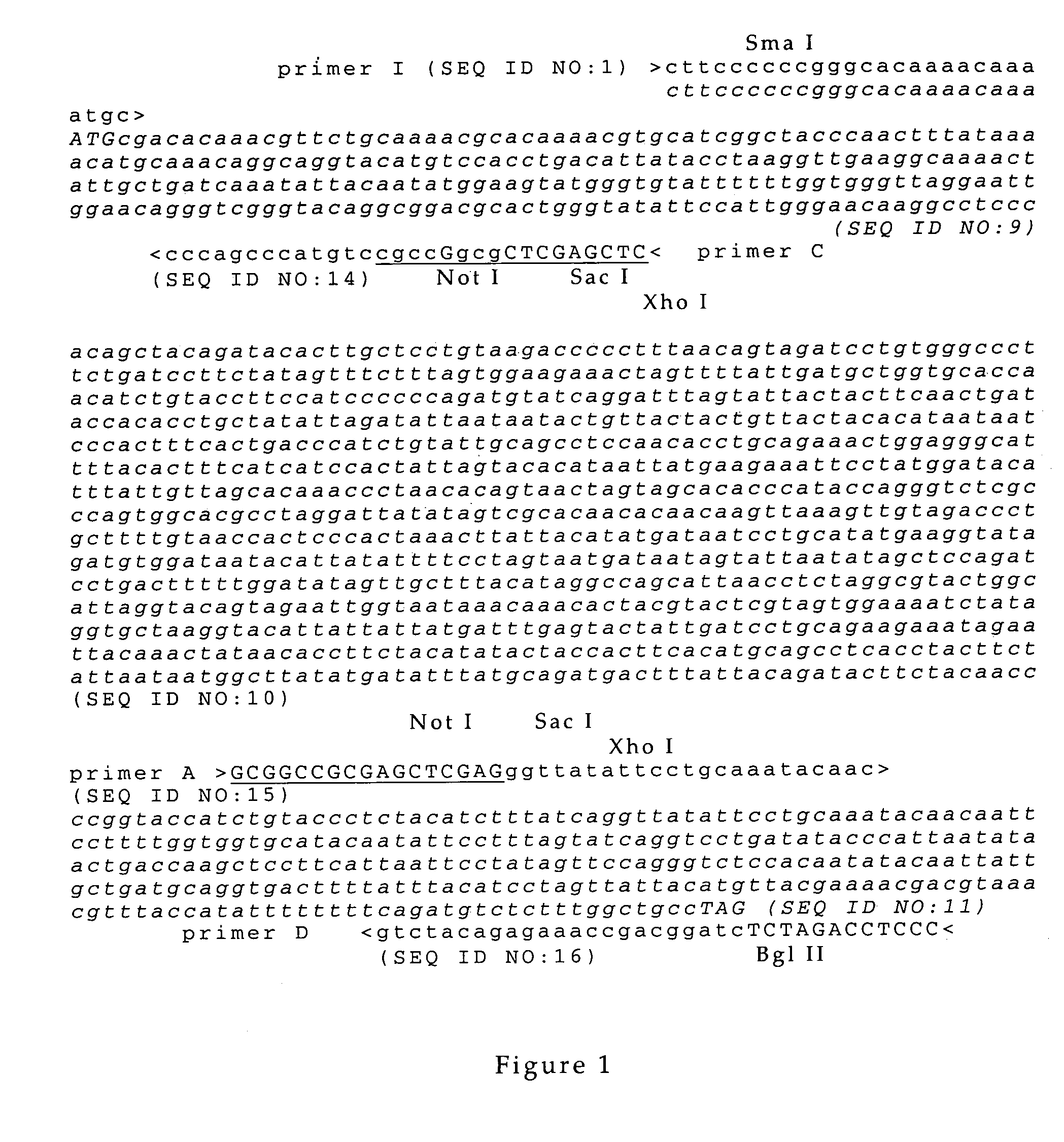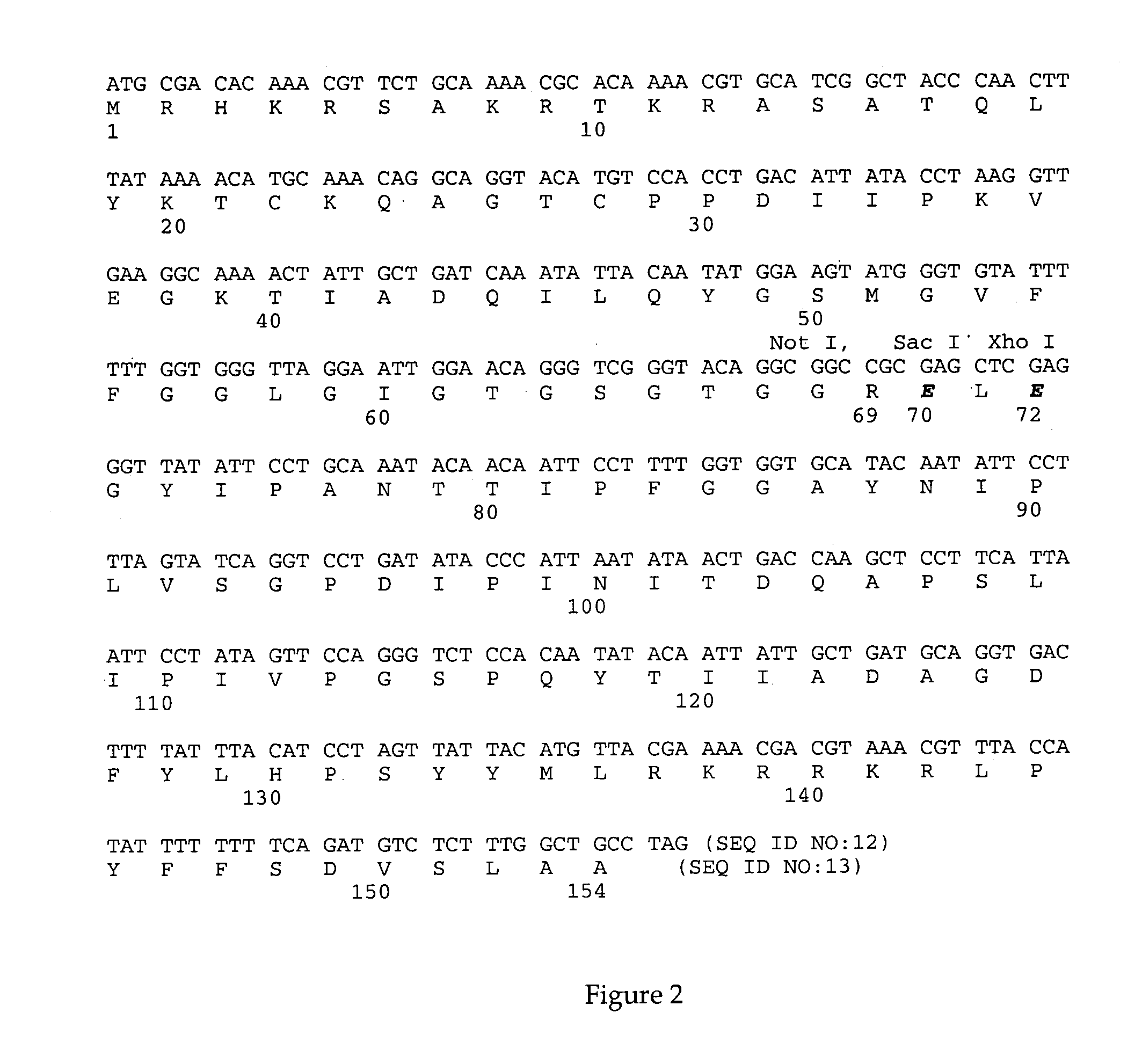Protein delivery system using human papillomavirus virus-like particles
a technology of human papillomavirus and protein delivery system, which is applied in the direction of viruses, peptides, drug compositions, etc., can solve the problems of limited capacity of entire l2 as a fusion partner to accept large fusion proteins, and limit its usefulness to deliver functional proteins into cells
- Summary
- Abstract
- Description
- Claims
- Application Information
AI Technical Summary
Benefits of technology
Problems solved by technology
Method used
Image
Examples
example 1
Construction of the Modified L2 Gene
[0028]The modified HPV16 L2 gene was constructed from the coding sequences for the amino-terminal 69 amino acids and the carboxy-terminal 84 amino acids (aa) of HPV16 L2 which were fused in frame by a synthetic polylinker that introduced unique Not I, Sac I, and Xho I restriction endonuclease recognition sites and resulted in the insertion of one glutamic acid residue and the mutation of a serine residue to glutamic acid. (FIG. 1).
[0029]PCR primers (Midland Certified Reagents; Midland, Tex.) were designed to amplify L2 sequences from the native L2 gene contained within the vector, pGal110 (Hofmann, K, et al 1995 Virology 209:506–518) into which the genes encoding HPV16 L1+L2 were inserted. (See FIG. 1).
[0030]Primers I (5′-CTT CCC CCC GGG CAC AAA ACA AAA TGC-3′; SEQ. ID. NO. 1) and C (5′-CTC GAG CTC GCG GCC GCC TGT ACC CGA CCC-3′; SEQ. ID. NO. 2) amplified a 265 base pair (bp) sequence encoding the amino-terminal 69 aa and 23 bp of upstream untrans...
example 2
Insertion of HPV E Protein- and Tat-Encoding Genes
[0035]The gene encoding HPV16 E2 was obtained by PCR amplification of a HPV16 positive clinical sample which was then inserted directly into the subcloning vector pCRII (Stratagene) and sequence verified as above. The E2 gene sequence was then modified in the following manner:
[0036]1) In-frame Xho I, Nae I, Not 1-containing DNA sequences were added to the amino terminal portion of E2. Additionally, Not I, Nae I, and Xho I-containing sequences were added to the carboxyl-terminal portion of E2 to facilitate insertion within E2 at the Not I, Xho I sites.
[0037]2) The DNA sequences were altered by PCR mutagenesis to encode alanine residues encode at residues glutamic acid 39 and isoleucine 73. This was designed to inactivate E2 protein function.
[0038]The modified HPV16 E2 gene described above was digested with Not I, Xho I and ligated with similarly digested YP3#1 vector. Transformants containing the properly-inserted E2 sequences were se...
example 3
Identification and Growth of Yeast Expressing Chimeric VLPs
[0040]Plasmid DNA of YP3#1 and derivatives described above were used to transform Saccharomyces cerevisiae (MATa, leu2-04, prb1:: HIS3, mnn9:: URA3, ciro) by the spheroplast method (Hinnen et al., 1978, Proc. Natl. Acad. Sci. USA 75:1929–1933). Transformed spheroplasts were plated onto selective (leucine minus) medium (Remel, Lenexa, Kans.). Clones were isolated through two rounds of single colony selection. Small liquid cultures of candidate clones were grown to high cell density in medium containing galactose. Crude extracts were prepared by vigorous agitation with glass beads followed by centrifugation. The clarified extracts were analyzed for expression of L1, the L2 component, and VLPs by various methods including SDS PAGE, ELISA, immunoblotting, and EIA, using monoclonal antibodies or monospecific polyclonal antisera that recognize L1, or L2, or the amino or carboxy termini of L2, or L1 VLPs, or E1, or E2, or E7, or an...
PUM
| Property | Measurement | Unit |
|---|---|---|
| temperature | aaaaa | aaaaa |
| temperature | aaaaa | aaaaa |
| pH | aaaaa | aaaaa |
Abstract
Description
Claims
Application Information
 Login to View More
Login to View More - R&D Engineer
- R&D Manager
- IP Professional
- Industry Leading Data Capabilities
- Powerful AI technology
- Patent DNA Extraction
Browse by: Latest US Patents, China's latest patents, Technical Efficacy Thesaurus, Application Domain, Technology Topic, Popular Technical Reports.
© 2024 PatSnap. All rights reserved.Legal|Privacy policy|Modern Slavery Act Transparency Statement|Sitemap|About US| Contact US: help@patsnap.com










